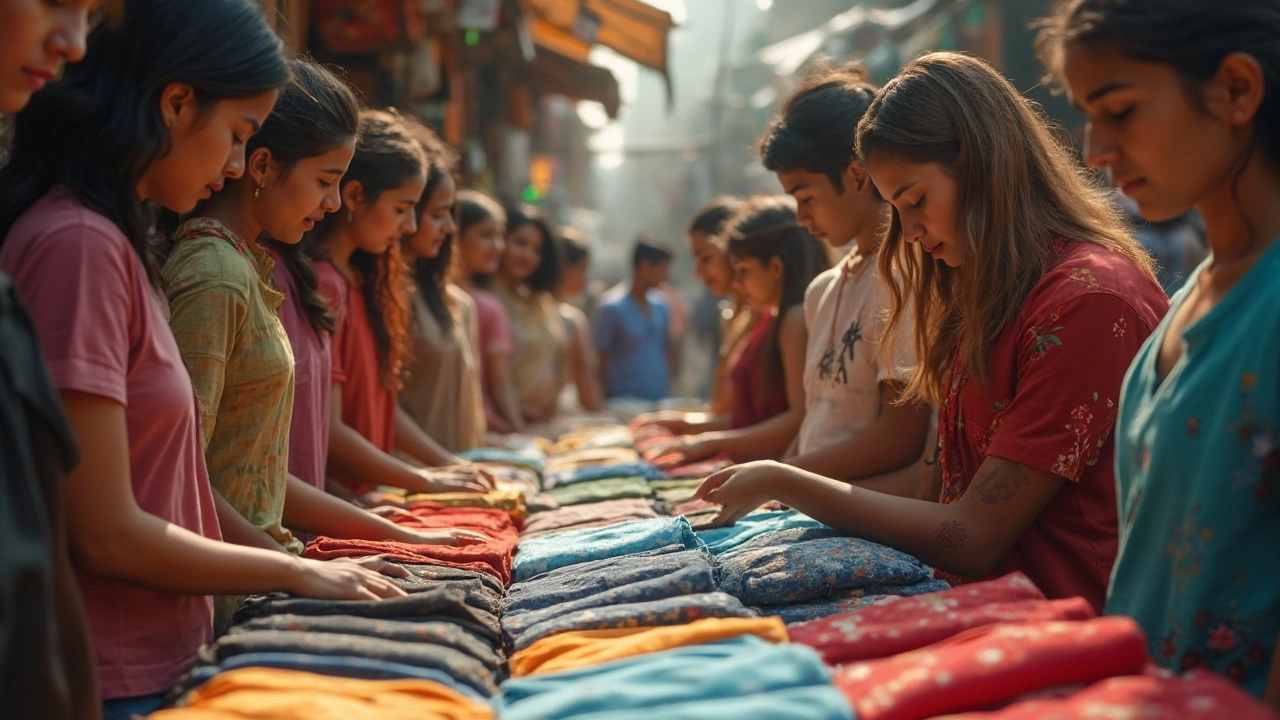Ever picked up a shirt that just felt... better? Not scratchy, not flimsy, just solid and soft. Chances are, you’ve run into a higher quality fabric. It’s not just hype—some materials really do last longer, keep their shape, and just feel better all day.
If you care about comfort, or even if you just hate shirts that stretch out after one wash, you’ll want to know what separates the best from the rest. Fabric matters big time. But 'high quality' can mean different things: is it softness? Strength? Or maybe how eco-friendly it is? Turns out, it can be all that and more. Let’s break it down, so the next time you’re T-shirt shopping, you’ll know what’s actually worth your money.
- What Does 'High Quality' Mean for T-Shirts?
- Cotton: Still the Top Dog?
- Blends, Bamboo, and Modern Alternatives
- Expert Tips for Picking a Great T-Shirt
What Does 'High Quality' Mean for T-Shirts?
There’s a reason your favorite t-shirt always ends up at the top of the clean laundry pile. High quality doesn’t just mean soft. It’s about how a shirt feels, how it fits, and how many washes it can take before looking like it’s been through a war. Let’s cut through the buzzwords—when someone says “highest quality material for t-shirts,” here’s what actually matters:
- Fabric Type: 100% cotton is the classic choice, but there’s a difference between cheap cotton and, say, long-staple Pima or Supima cotton. Longer fibers mean fewer loose ends, so shirts stay smooth and strong.
- Yarn Quality and Thread Count: Finer yarns and higher thread counts usually mean a softer, denser fabric. Think of it as the difference between a scratchy towel and a plush one.
- Construction: Look at how the t-shirt is made. Reinforced seams, tight stitching, and even shoulder tape can boost a shirt’s toughness, so it holds its shape instead of sagging out after a month.
- Dye and Finish: High quality dyes hold their color way longer, and some shirts are even enzyme-washed for extra smoothness. If the colors look faded after just a few washes, quality probably wasn’t a priority.
| Quality Factor | What To Look For |
|---|---|
| Material | Pima/Supima cotton, combed ringspun cotton, or smart blends |
| Construction | Reinforced seams, double-needle stitching |
| Finish | Reactive dyes, enzyme-washed finish |
High quality t-shirts don’t feel flimsy or see-through. They survive laundry day after laundry day without losing their fit or softness. The next time you're shopping, run your fingers over the fabric and hold it up to the light—thin, twisty, or uneven fabric is probably not going to last.
Cotton: Still the Top Dog?
If you ask most people what the best t-shirt material is, cotton usually gets the top spot. It’s been the go-to for ages because it’s soft on the skin, breathable, and absorbs sweat pretty well. But here’s the catch—not all cotton is created equal.
Want to know why some cotton tees feel softer and last longer than others? It’s all about the type and how it’s made. Let’s break it down:
- Regular cotton: This is your standard cotton, found in tons of basic tees. It’s comfy but can shrink or fade faster than premium types.
- Combed cotton: This stuff is brushed to remove short fibers, which means it feels smoother against your skin and is less likely to pill after a wash.
- Ring-spun cotton: The fibers here are twisted into a stronger, finer strand, so the shirt feels softer and also holds up longer with repeated use.
- Pima cotton: Super soft, thanks to extra-long staple fibers. It’s pricey, but you can literally feel the difference—many people call it the Cadillac of high quality t-shirts.
- Organic cotton: Grown without chemical fertilizers or pesticides. It's great if you care about the environment, and it usually has less scratchy feel.
Let’s get specific with some numbers. Most standard cotton t-shirts use fabric around 120-140 grams per square meter (gsm). Heavier tees (160-180 gsm) are sturdier and tend to hold their shape better, but lighter shirts breathe better in hot weather. Here’s a quick look:
| Type of Cotton | Softness | Durability | Price Range |
|---|---|---|---|
| Regular Cotton | Medium | Medium | Low |
| Combed Cotton | High | High | Mid |
| Ring-Spun Cotton | Very High | Very High | Mid to High |
| Pima Cotton | Ultra | Ultra | High |
| Organic Cotton | High | High | Mid to High |
The real selling point for cotton is comfort. Most people just like the way it feels. But here’s a tip: if you’re shopping for a shirt that you’ll wear all the time, look for ring-spun or combed cotton and check if it’s pre-shrunk. That way, you’ll avoid the dread of your shirt getting tiny after its first hot wash.
So, is cotton still king? For many, yes. But if you want a shirt that really goes the distance, don’t go for the cheapest stuff out there—these little fabric differences make a huge impact on how your t-shirt looks and feels six months down the line.

Blends, Bamboo, and Modern Alternatives
Pure cotton isn’t the only big player in the t-shirt fabric guide anymore. These days, you’ll see tees made with all kinds of blends—usually mixing cotton with polyester or rayon. Why do brands mix it up? Simple: blends try to grab the best from every fiber. For example, cotton-poly mix t-shirts usually hold their shape better in the wash, dry faster, and wrinkle less than 100% cotton. That means less fuss over shrinking or fading, plus they’re lighter and often more budget-friendly.
There are actually a few classic blend ratios you’ll spot on labels:
- 50/50 (cotton/poly): Soft, durable, and stays the same size after you wash it, unlike some pure cotton shirts.
- Tri-blends (cotton, polyester, rayon): Super soft with a vintage feel. Great for movement and breathability.
But maybe the real buzz lately is about bamboo fabric. Bamboo-based t-shirts can feel crazy soft, almost like a mix between silk and cotton, and they’re pretty tough at the same time. People love bamboo because it’s naturally breathable, resists odor, and is marketed as eco-friendly since bamboo grows fast with limited chemicals. Remember though, some bamboo shirts are actually bamboo rayon, processed with chemicals—so not all bamboo tees are the same when it comes to being green.
Let’s throw a spotlight on newer fabrics, too. Materials like TENCEL (from eucalyptus trees), recycled polyester, and even modal (from beech trees) are designed for a better feel, moisture control, and eco-friendliness. Many brands are mixing these up in ways that try to beat plain old cotton or poly for active wear and even everyday use.
| Material | Softness | Durability | Eco Impact |
|---|---|---|---|
| 50/50 Cotton/Poly | Medium | High | Low |
| Bamboo (Viscose) | Very High | High | Varies* |
| TENCEL (Lyocell) | High | Medium | High |
| Tri-blend | Very High | Medium | Medium |
*Eco impact depends on the manufacturing process for bamboo-based materials.
Bottom line? If you want a shirt that lasts, feels nice, and maybe even helps the planet, don’t skip the label. Blends, bamboo, and these newer fibers can outperform old standards—and nail that sweet spot between comfort and performance. Always check if the shirt is truly eco-friendly or if the buzzwords are just for show.
Expert Tips for Picking a Great T-Shirt
Choosing a real high quality tee isn’t rocket science, but a few smart moves can save you from saggy collars and see-through disappointment. Here’s what’s worth checking for when you’re shopping for the best t-shirt material—or just want a tee that’ll last.
- Check the label first. Look for 100% cotton if you want softness and breathability. If you spot "Supima" or "Pima" cotton, that’s even better—these types are known for extra-long fibers, which makes the fabric smoother and stronger. Organic cotton is another plus since it’s grown with less chemicals.
- Feel and twist the fabric. Give the shirt a little tug and twist. Good tees bounce back to shape and feel a bit weighty, not paper-thin. If you can see your hand right through it, expect it to wear out sooner.
- Look at the stitch work. Higher quality t-shirts use double-stitching along the seams and hems. Flip the shirt inside out and check for loose threads or cheap single stitching—the less you see, the longer the shirt will last.
- Sizing matters. High quality brands usually have more consistent sizing. Cheaper shirts can shrink or get twisty after the first wash. If you’re unsure, look for brands that pre-shrink their cotton.
- Beware of crazy blends. Some blends (like 50/50 cotton and polyester) are fine, especially for gym wear because they dry quickly, but too much synthetic can mean less breathability. Bamboo and modal feel soft but can pill if the shirt’s not made well.
Here’s a quick comparison of popular t-shirt fabric types and what you usually get with each:
| Fabric Type | Softness | Durability | Best For |
|---|---|---|---|
| Supima/Pima Cotton | Very High | Excellent | Everyday, dress-up tees |
| Regular Cotton | High | Good | Everyday basics |
| Cotton-Polyester Blend | Medium | High | Sports, casual wear |
| Bamboo/Modal | Very High | Moderate | Soft lounge tees |
Last tip: if you’re buying online, don’t just go by photos. Read real customer reviews and see what people are saying about shrinkage, feel, and how the color holds up. People love talking about their favorite t-shirts—let their pain and joy guide you to the good stuff.
